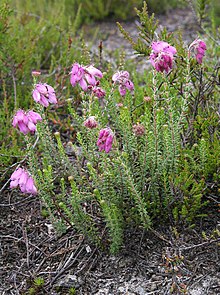Erica tetralix
| Erica tetralix | |
|---|---|

| |
| Scientific classification | |
| Kingdom: | Plantae |
| Clade: | Tracheophytes |
| Clade: | Angiosperms |
| Clade: | Eudicots |
| Clade: | Asterids |
| Order: | Ericales |
| Family: | Ericaceae |
| Genus: | Erica |
| Species: | E. tetralix
|
| Binomial name | |
| Erica tetralix | |

| |
Erica tetralix, the cross-leaved heath, is a species of flowering plant in the family Ericaceae, native to western Europe.
Description
[edit]It is a perennial subshrub with glandular leaves in whorls of four (whence the name). Appearing in summer and autumn, small pink bell-shaped flowers droop in compact clusters at the ends of the shoots.
Similar species
[edit]Related species E. cinerea has glabrous leaves in whorls of three. Calluna vulgaris has much smaller and scale-like leaves in opposite and decussate pairs.[1]
Taxonomy
[edit]The sticky, adhesive glands on leaves, sepals and other parts of the plant prompted Charles Darwin to suggest that this species might be a protocarnivorous plant, but little, if any, research has been done on this.[2]
Distribution and habitat
[edit]E. tetralix is native to western Europe from southern Portugal to central Norway, as well as a number of boggy regions further from the coast in Central Europe such as Austria and Switzerland. It has also been introduced to parts of North America.
E. tetralix can become a dominant part of the flora in bogs, wet heaths, and damp coniferous woodland.[3]
Ecology
[edit]A species of Trialeurodes whitefly discovered in 1971 was named T. ericae for the plant, due to its frequent association with it.[4]
Cultivation
[edit]In cultivation, like other heathers, E. tetralix requires an acidic soil, as it is a calcifuge. Numerous cultivars have been developed for garden use, of which E. tetralix f. alba 'Alba Mollis'[5] (a white-flowered variety) and E. tetralix f. stellata 'Pink Star'[6] have gained the Royal Horticultural Society's Award of Garden Merit.[7]
In culture
[edit]It appears in the 1938 German marching song "Erika" by Herms Niel.
References
[edit]- ^ Clive Stace (2010). New Flora of the British Isles (3rd ed.). Cambridge University Press.
- ^ Darwin, Charles (1875). Insectivorous Plants. London: J. Murray.
- ^ "Distribution map (polar view)". Linne's Webbplatz. Swedish Museum of Natural History. Archived from the original on 2005-11-22.
- ^ Bink-Moenen, Rosita M. (1 February 1976). "A new whitefly of Erica tetralix: Trialeurodes ericae sp. n. (Homoptera, Aleyrodidae)". Entomologische Berichten. 36 (2). Amsterdam: 17.
- ^ "Erica tetralix f. alba 'Alba Mollis'". Royal Horticultural Society. Retrieved 8 June 2020.
- ^ "Erica tetralix f. stellata 'Pink Star'". RHS. Retrieved 8 June 2020.
- ^ "AGM Plants - Ornamental" (PDF). Royal Horticultural Society. July 2017. p. 36. Retrieved 6 February 2018.
External links
[edit] Media related to Erica tetralix at Wikimedia Commons
Media related to Erica tetralix at Wikimedia Commons
